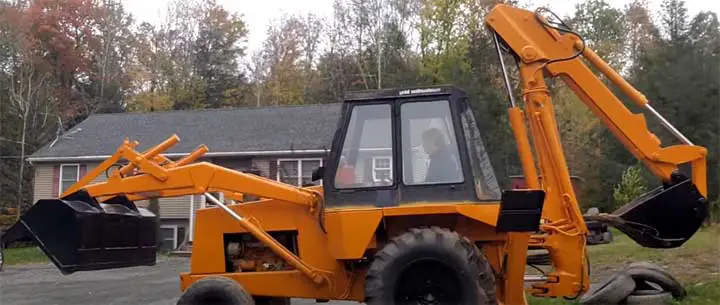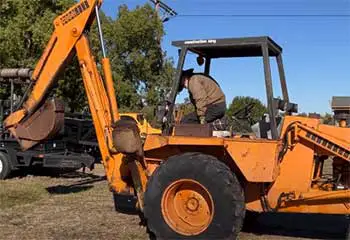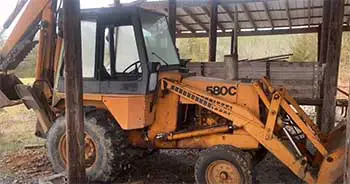The Case 580C backhoe is a versatile and powerful machine used extensively for construction, landscaping, and excavation work. As with any heavy equipment, the 580C is susceptible to a range of mechanical issues and wear and tear over time.
In this article, we’ll provide an in-depth look at some of the most common problems that owners and operators encounter with the Case 580C backhoe.
Common Problems With Case 580C Backhoe

Here is a list of these common 4 problematic areas of Case 580C Backhoe:
- Engine Problems
- Hydraulic System Problems
- Drivetrain Problems
- Structural and Mechanical Issues
Let’s elaborate these problems.
Engine Problems
As the power plant of the backhoe, the engine is prone to various issues, especially as the machine accumulates hours of use. Some things to look out for include:
- Overheating
Overheating is one of the most common engine problems on the 580C. Contributing factors include low coolant levels, a failing water pump, clogged radiator, damaged fan, faulty thermostat, or failure of the cooling system hoses.
Overheating can lead to blown head gaskets, cracked cylinder heads, and engine damage if left unchecked.
To troubleshoot, carefully inspect the cooling system components, check for leaks, and perform pressure tests. Replace any worn or damaged parts and ensure proper coolant levels. Improper maintenance often leads to overheating over time on the 580C’s diesel engine.
- Oil Leaks
Oil leaks are messy and pose both short and long-term risks. On the 580C, common sources for oil leaks include the front and rear crankshaft seals, valve cover gasket, oil pan gasket, and engine oil filter. Oil leaks lead to low oil levels, resulting in inadequate lubrication and accelerated wear.
Inspect under the machine routinely for any signs of dripping or pooling oil. Have oil leaks traced to the source and all worn seals and gaskets replaced to prevent further leakage. Keeping up on engine maintenance goes a long way in minimizing oil leaks.
- Fuel System Problems
Problems with the fuel delivery system can cause the 580C to exhibit poor starting, lack of power, misfiring, or engine stalling. Faulty fuel filters, injectors, pumps, and lines are often to blame.
Contaminated or poor quality diesel fuel can also negatively impact performance.
By systematically examining each component, testing fuel pressure and quality, and replacing any questionable parts, most fuel system gremlins can be addressed. Using high quality fuels and regularly changing the fuel filter according to maintenance schedules helps optimize the system.
- Smoking, Burning Oil
Excessive smoking or oil consumption points to internal wear issues within the 580C’s engine. Worn piston rings, cylinders, valve guides, and turbocharger problems can all lead to oil being burned in the combustion chambers.
A compression test can isolate any cylinders with low compression from worn rings or valves. Overhaul of the engine including new rings, valve repairs, cylinder honing, or turbocharger rebuild may be required in severe cases. Strict oil change intervals should be followed to help maximize engine life.
- Lack of Power
Diminished power when operating the backhoe attachments or sluggish performance when roading or driving up grades are very telling signs. This often stems from normal engine wear, clogged air or fuel filters, engine computer faults, or complications with the turbocharger.
Running diagnostics on the computerized engine controls can isolate sensor malfunctions or software faults leading to power issues. The turbocharger can suffer from carbon buildup or physical damage, impairing its air boosting capabilities.
Filters and fluids should be inspected and swapped out per the maintenance schedule.
Hydraulic System Problems
Hydraulics are the lifeblood of the 580C backhoe, powering the boom, arm, bucket, swing, steering, and stabilizers. Hydraulic problems lead to decreased power or the inability to operate these functions. Some key things to watch out for:
- Overheating

Much like engine coolant, hydraulic fluid needs to stay within an optimal temperature range.
Overheating of the hydraulic oil leads to breakdown of its lubricating properties.
Signs include faded or discolored fluid, foaming, and noticeable lack of power.
Causes of overheating include insufficient fluid levels, obstructed cooling lines, malfunctioning radiator fans, too much back pressure, and using the wrong weight hydraulic oil.
Adding oil or doing fluid exchanges with the specified grade along with repairing any cooling and flow deficits can help get temperatures back to normal.
- Leaks
Given the high pressures within the system, hydraulic fluid leaks are an ever-present hazard with the 580C backhoe. Leaks often stem from damaged hydraulic hoses, cylinder seals, cracked housings, and loose fittings.
Even small leaks left unattended can lead to significant fluid loss and system degradation.
Routinely inspect hoses, fittings, cylinders, and valves for any evidence of wetness or dripping. Replace damaged hoses and components immediately. Keeping trash and debris from damaging hoses or fittings helps reduce leaks. Make sure operating pressures do not exceed component specifications.
- Pump Failure
The hydraulic pumps are constantly cycling fluid to the various actuators and valves. Gradual wear, contamination, incorrect fluid use, or overheating will eventually cause pump damage or failure.
Symptoms include noticeable loss of power, increased noise, and difficulty performing simultaneous operations.
Replacement of the affected pump or pumps will be required. Using well-filtered hydraulic fluid, avoiding pump cavitation, monitoring pump case drain screens, and testing pump output per the manual can all help minimize premature pump failure.
Consider maintaining a spare pump for faster repairs.
- Clogged Filters
Much like an engine air filter, the hydraulic filters have to be changed regularly to avoid becoming restricted. Plugged filters cause a lack of fluid flow, resulting in hydraulic starvation and component damage.
The system filter indicator gauge can confirm suspected filter clogging.
Closely follow the prescribed interval for changing hydraulic filters. Use quality filters specifically designed for the high pressures found in backhoe hydraulic systems. Consider adding kidney-loop filtration to catch even more contaminants.
Regular fluid analysis also provides insight into filter condition.
Drivetrain Problems
Transferring engine power to move the backhoe down the road or across the job site relies on a rugged drivetrain. Issues here include:
- Transmission Slipping
Transmission slipping is evident when engine rpms surge but machine speed does not correspondingly increase. Common causes include low transmission fluid, worn clutch packs, bad solenoids, or overall internal wear.
Delayed or harsh shifting between gears can also signal issues.
Check the transmission fluid level and top off if low. Further diagnosis may require fluid and filter changes, inspection of the shift solenoids, or transmission teardown if slipping persists. Rebuilds or replacement may be necessary in severe cases of transmission wear or damage.
- Axle and Final Drive Leaks
Lubricant leaks around the axles and final drive housings lead to eventual and often catastrophic component failure. Loose covers, damaged seals, and blown gaskets due to overfilled fluid are typical culprits. Evidence includes wetness around the housings and decreased lube levels.
Repairing leaks early on prevents serious drivetrain damage. Ensure housings are torqued to spec with properly fitted seals and gaskets. Monitor lubricant quality and levels closely.
Replace fluid as recommended to minimize contamination.
- Tire Wear
Premature or uneven tire wear points to potential issues with the drive axles or braking system. Insufficient inflation, alignment problems, drivetrain vibrations, and improperly functioning differentials can all contribute to tire wear. Not correcting these issues results in recurring tire replacements.
Inspect tire pressures and tread depth regularly. Have the machine thoroughly looked over for any drivetrain vibrations or early signs of abnormal tire wear. Service differentials and hubs as prescribed. Consider installing rear suspension stabilizers to combat axle twist.
Structural and Mechanical Issues
In addition to the major systems covered already, there are a few other mechanical and structural problem areas common to the Case 580C backhoe.
- Broken Boom and Arm Hinges

The repeated hard use, swinging, and positioning forces applied to the boom and arm naturally take a toll over time.
Cracking and failure around the main pivot hinge joints is not uncommon.
This makes positioning the attachments extremely difficult or impossible.
Improper use, overloading, and metal fatigue all contribute to hinge cracking. Carefully inspect the boom and arm hinges periodically for any hairline cracks or structural issues. Reinforce or replace damaged components before catastrophic failure occurs.
- Rust and Corrosion
As with any steel construction equipment, rust and corrosion will attack unprotected areas and compromise structural integrity. Once significant pitting occurs, it can be extremely difficult and costly to repair. The chassis, boom, and attachment joints are particularly prone to rust issues.
Touch up paint chips and scratches immediately to prevent surface rust. Wash off corrosive agents like fertilizers or road salts as soon as possible. Consider adding boom wraps or guards to combat damage in vulnerable areas. Apply rust inhibiting sprays and lubricants to outriggers and pivots.
- Faulty Control Valves
Hydraulic control valves direct fluid flow to the various cylinders and motors to operate the backhoe functions. Over time, they are subject to wear, contamination damage, or maladjustment. Symptoms include delayed movement, weak force, and inconsistent operation.
Test valves by passing fluid directly through them to isolate flow or pressure issues. Clean or replace damaged spools and springs as needed. Verify valves shift fully and regulator settings are correct.
Flush contaminants from the system. Retrofit updated valve sections if older controls prove too problematic.
- Cab Noise and Vibration
The 580C’s cab serves as the operator’s work environment for full shifts. Excessive noise and vibration during machine operation leads to fatigue and safety risks. Contributing factors include worn cab mounts, poorly sealed doors, missing insulation, mechanical issues, and road surface conditions among others.
Inspect cab mounts and replace any that are cracked or deteriorating. Ensure cab sealing kits are intact around doors and windows. Check for missing or damaged sound dampening insulation.
Address any drivetrain problems that generate vibration. Use care when traveling over extremely rough terrain.
Frequently Asked Questions (FAQ)
The Case 580C model backhoe was manufactured for over 25 years, from 1987 up until 2007. During that long production run, there were incremental improvements and variants for specific markets, but in general the 580C remained relatively unchanged at its core. Many examples are still in operation today across the world.
Case backhoes like the 580C have a well-earned reputation for quality and reliability, especially when properly maintained and operated. Case Construction Equipment has been building backhoes since 1957 and the designs have evolved to become proven performers. Their strength lies in relatively simple mechanics coupled to rugged components.
The Case 580C came equipped with a 4-cylinder, turbocharged diesel engine. Horsepower ratings varied slightly by year and configuration from approximately 70 HP up to 100 HP maximum. This provided ample power for digging, lifting, and manipulating loads within its designed capabilities. Fuel efficiency was decent for the class as well.
With the standard loader bucket installed, the approximate maximum lift capacity of a Case 580C backhoe is around 3,100 pounds. The maximum lift height to the bucket pin is just over 14 feet. These specs make it a highly capable digging and lifting machine for a variety of earthmoving, excavation, and material handling jobs. Larger 580 models can lift even heavier loads.
Closing Remarks
The Case 580C backhoe is prone to a variety of issues over its lifetime, especially if maintenance is neglected. Problems can occur with the engine, hydraulic system, drivetrain, and structural components. Common symptoms include overheating, leaks, slipping, power loss, cracking, and abnormal wear.
Staying on top of routine maintenance and repairs is key to minimizing breakdowns and extending the machine’s service life. Case 580 models are well-built and deliver reliable performance when properly cared for.
But like any complex mechanical equipment, they require diligent upkeep and attention to detail to keep everything operating smoothly.
